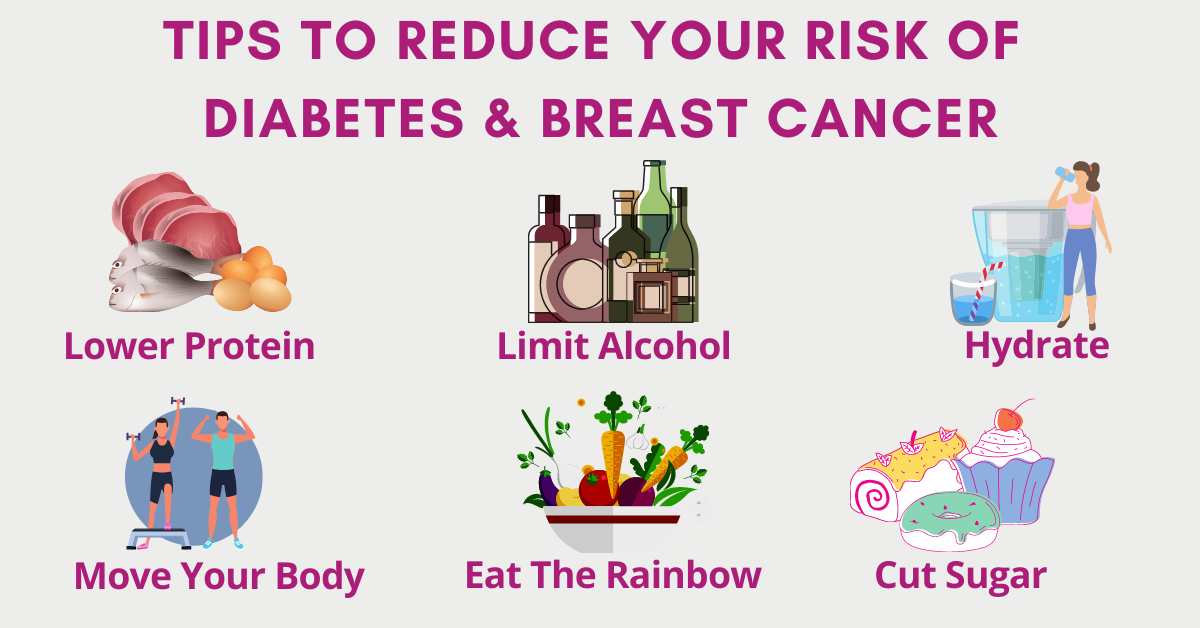
According to 2019 figures by the U.S. Centers for Disease Control (CDC), Type 2 diabetes and cancer are both among the top ten causes of death in the United States. These statistics probably don’t surprise you. What may come as a shock, however, is that both cancer and diabetes stem from the same basic factors. The good news is that both can be prevented and sometimes even healed using the same lifestyle and dietary changes!
The Connection Between Cancer and Diabetes
Consider these statistics:
-A major 2008 study conducted at the University of Texas M.D. Anderson Cancer Center found that a mere 5-10% of all cancer cases are caused by “bad genes.” The vast majority of all cases could be directly connected to lifestyle choices, diet, and environmental toxins.
-According to the World Health Organization, in the 35 years between 1980 and 2014, the number of diabetes cases quadrupled. The cause, according to thousands of published reports, was diet, obesity, and a sedentary lifestyle.
Are you beginning to see a connection?
For both cancer and Type 2 diabetes, it is not genetics that causes the development of disease but rather epigenetics. Epigenetics refers to all of the external factors that may be in play in a person’s life which can cause disease-producing genes to “turn on.” If you are new to the concept of “epigenetics” and how it may influence your Breast Cancer risk, check out my article on the subject HERE.
Going a step further, for both diabetes and cancer, it is specifically how lifestyle and an unhealthy diet (especially high-sugar foods) affect insulin and glucose levels that can lead to the development of both diseases.
The Metabolic Components of Both Diabetes and Cancer
If you are prediabetic or diabetic, then you are probably familiar with what insulin does in the body. If you want to prevent or heal cancer, it is vitally important that you understand how insulin imbalance can contribute to raising your risk as well.
Insulin is a hormone. It is made by the pancreas, the main energy-converting “factory” in the body. Diabetes happens when a person is not able to make enough insulin for energy conversion to take place in the proper manner (or at all). When insulin does not do its job, glucose from food stays in the bloodstream. This can cause blood sugar “spikes” and a myriad of both short and long-term side effects.
For someone with Type 2 diabetes, eating too many carbs at once can lead to kidney failure, seizure, and even death. Even when a person is “insulin sensitive” (i.e. hypoglycemic or pre-diabetic), the risk of dangerous complications over time is high.
Now let’s switch on to cancer. Otto Warburg said it best over 100 years ago: the main fuel for cancer is glucose.
If you are just starting out on your healing journey, you may not yet be aware of how much cancer cells love glucose. For a quick primer of sugar’s connection to cancer tumor growth (or review if you are already aware), check out this article HERE.
Cancer tumors’ love affair with sugar is why many experts call cancer a “metabolic” disease. Cancer develops at the cellular level, as diabetes does, and it responds to glucose as well.
IGF-1: A Common Link
IGF-1, or Insulin Growth Factor 1, adds another layer of connection between the progression of both diseases. IGF-1 is a typical marker for diabetes on laboratory tests. It is produced by the liver and is a hormonal protein that promotes cellular growth. It is an important substance to have in abundance if you are a growing child. Once you reach adulthood, however, high levels of IGF-1 can be a red flag. Those with low immune function tend to have higher levels of IGF-1, according to a 2014 study on postmenopausal women with Breast Cancer.
The fact is that high levels of IGF-1 can be an indication of a higher risk for both diabetes and reproductive cancers like Breast Cancer. A comprehensive German investigation on the relationship between IGF-1 and ER-positive Breast Cancer found a connection between estrogen cellular receptor sites in the mammary glands and IGF-1. This connection led the research team to conclude that IGF-1 could potentially raise one’s risk of this type of cancer.
Do These 6 Things NOW to Reduce Your Risk of Both Cancer and Diabetes
If all of the above doesn’t convince you of the obvious connections between these two diseases, this may:
According to a 2010 report compiled by the American Cancer Society and the American Diabetes Association, “[e]pidemiologic evidence suggests that people with diabetes are at a significantly higher risk of many forms of cancer.”
One of the studies cited in the report was a US-Canadian joint investigation of 600 post-menopausal women which found a high correlation between obesity, high insulin levels, and breast cancer.

The good news is that when you focus on healing one disease, the risk of the other naturally goes down as well. Here are 6 go-to actions you can take NOW to reduce your risk of both diabetes and cancer:
#1 Cut the sugar.
Every person’s metabolism is unique. One person may thrive on a vegetarian diet while another may get amazing results by going keto. There are, however, some basic nutritional rules that apply to all healing.
The first guideline that makes sense for both diabetes and cancer is to stay away from refined and processed sugar. That includes simple carbs that can come from white bread, pasta, and white rice. Research across the board has found that restricting carbohydrates can lower systemic inflammation, balance blood sugar, and even reduce your risk of cancer. Replace the sugar with healthy fats such as omega 3-rich olive, avocado, and coconut oil as well as grass-fed butter or ghee if you eat them. Adding healthy oils can begin the process of detoxification and gut healing which can positively affect your metabolism over time as well.
#2 Eat the rainbow.
The next guideline is to add a rainbow of vegetables and low-sugar, high-antioxidant fruits like blueberries to your diet. Food really is medicine. Veggies like broccoli, celery, and kale and low-sugar fruits like berries have essential minerals such as selenium and magnesium. Every one of them also has a laundry list of vitamins like C.B and A (beta carotene). Vegetables also contain phytonutrients such as sulforaphane (found in cruciferous vegetables) which have been shown to turn on healthy genes and silence tumor-promoting genes.
#3 Hydrate.
Also, make sure you are drinking enough water. A good rubric is to consume half your weight in ounces of fresh, filtered, non-fluoridated water every day. The human body is about 80% water when we are born. As we age, this percentage declines but even the bodies of elderly individuals are still about 60% water.
Water is one of the major detoxifiers we have that is cheap and readily available. Staying adequately hydrated can also improve digestion and the absorption of nutrients can help muscles and joints, and can decrease pain.
#4 Lower the protein levels.
Studies looking at both cancer and diabetes have found that both conditions can improve when protein is reduced in the diet. A portion of beef that is the size of a deck of cards, for example, is really all you need on your plate. And if you do eat meat, make sure that it is organic, grass-fed, pasture-raised, hormone-free, and antibiotic-free.
A study conducted by Dr. Valter D. Longo and colleagues at the University of Southern California found that lower protein levels overall were linked to lower IGF-1 levels. The study, which was published in the journal Cell Metabolism in 2014, also found that plant-derived proteins were associated with lower mortality rates than animal-derived. That being said, be sure to consult with your natural health professional, health coach, or nutritionist to find out what works best for you.
#5 Limit alcohol and cut smoking.
Two of the major lifestyle risks for cancer are mentioned in the M.D. Anderson’s study (see above) was about excessive alcohol consumption and cigarette smoking. I am not even going to go into all the verified health risks of cigarette smoking. I am sure you know of them, so if you are still smoking and want to stay both diabetes and cancer-free, stop now.
In terms of alcohol consumption, keep in mind that alcohol is a simple sugar. It will spike glucose and can feed cancer as well. If you are preventing disease, the best bet is to stick with a glass of red wine every once in a while. Also, for Breast Cancer prevention, stay away from beer, which has been shown to cause hormone imbalance in women.
#6 Exercise!
In study after study, moderate exercise every day has been shown consistently to lower the risk of all diseases, including diabetes and Breast Cancer. There are many reasons why. Exercise can lower inflammatory markers, balance stress hormones, stabilize blood sugar, and oxygenate the blood and brain.
In addition, physical activity can also stimulate a process called “mitochondrial biogenesis.” This is a neurological mechanism by which the mitochondria in healthy cells become stronger and more efficient.
The U.S. National Institutes of Health recommend a total of 2.5 hours of moderate exercise (like brisk walking) per week. This breaks down to a 30-minute walk, five times a week.
Supplements Can Reduce the Risks of Both
If you are putting all of the above into play in your life, then you are well on your way to totally reducing your risk for both diabetes and cancer.
Supplements can sometimes be the “missing link” that will push your health goals to the next level.
The reason why I almost always recommend some form of key supplementation to women with Breast Cancer is simple. If you are ill and your immune system is low, then the odds are you are not getting the proper nutritional support that your body needs.
Sometimes the body just needs a little help to get it back on track and balanced toward healing. This is especially true in our modern, toxin-filled, and soil-depleted world. Some supplements that may be beneficial for both diabetes and cancer include CoQ10, Resveratrol, Alpha Lipoic Acid, and Biotin.
Remember that if you have diabetes or cancer, you can heal! It is simply a matter of using food as medicine and changing just a few healthy lifestyle patterns. You will see results if you find the right rhythm for you in terms of diet and healthy lifestyle, keep a positive attitude, and then stick to it!
